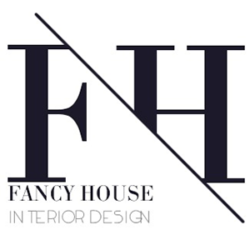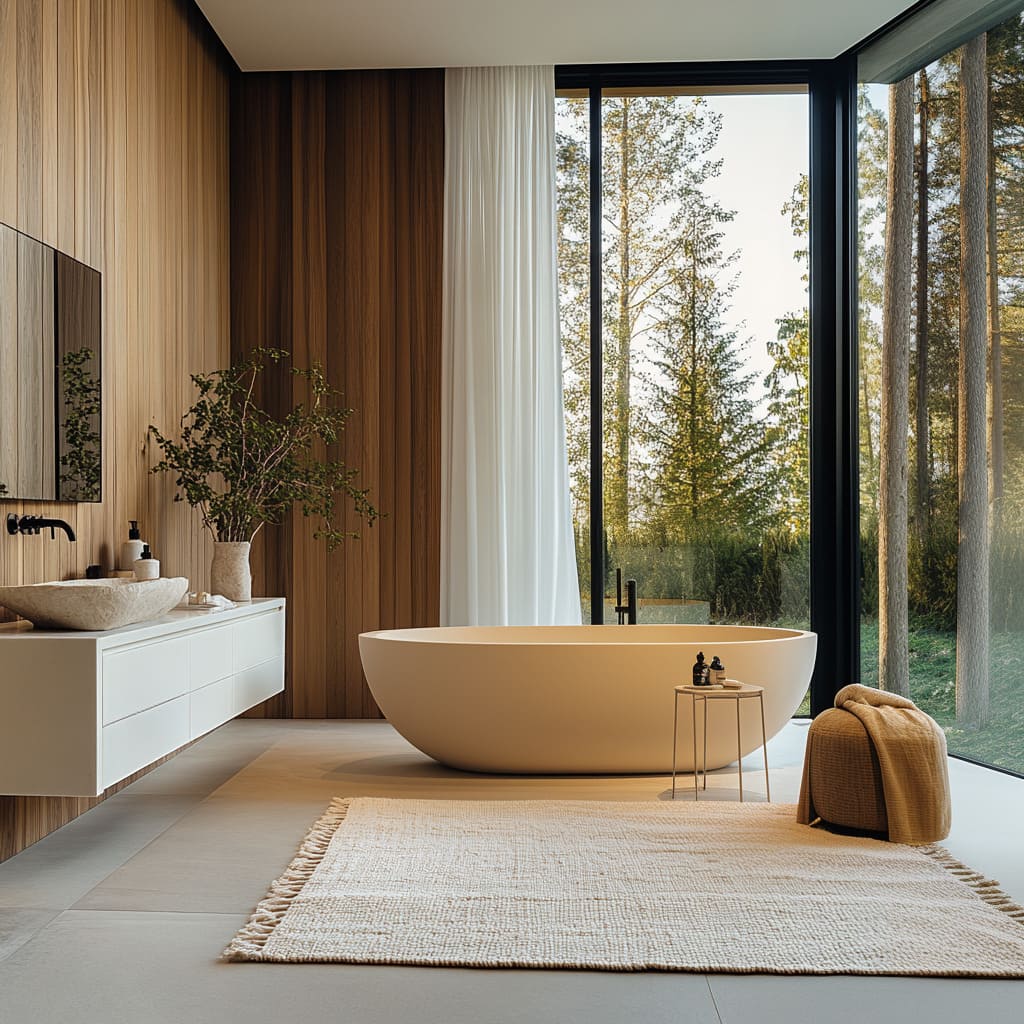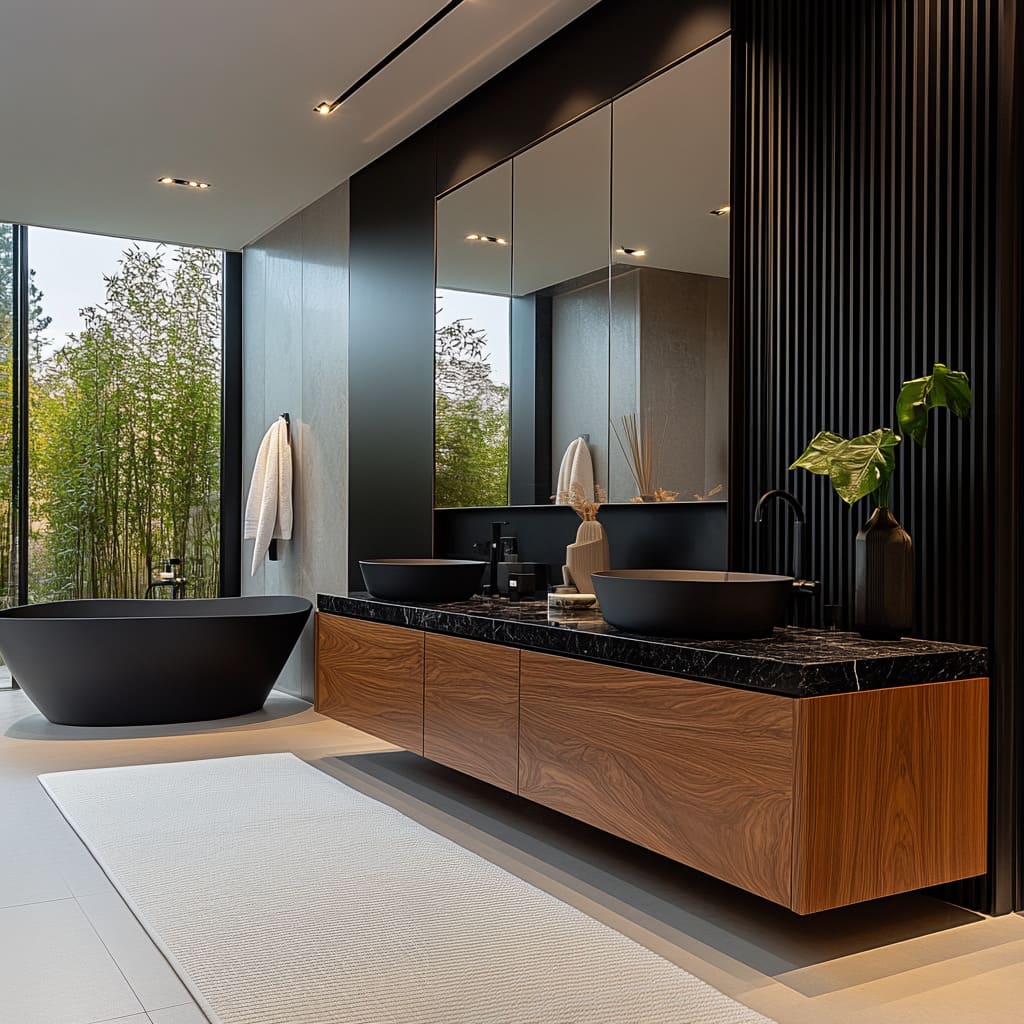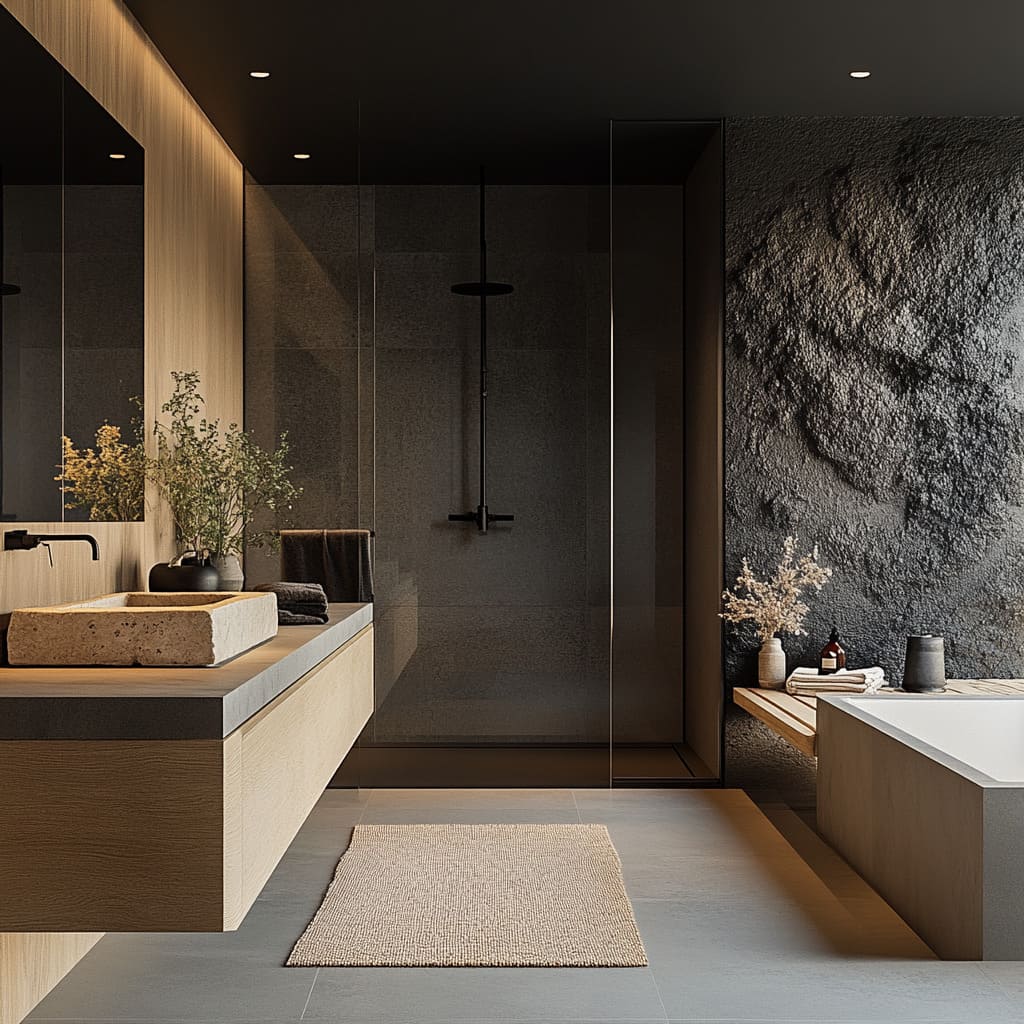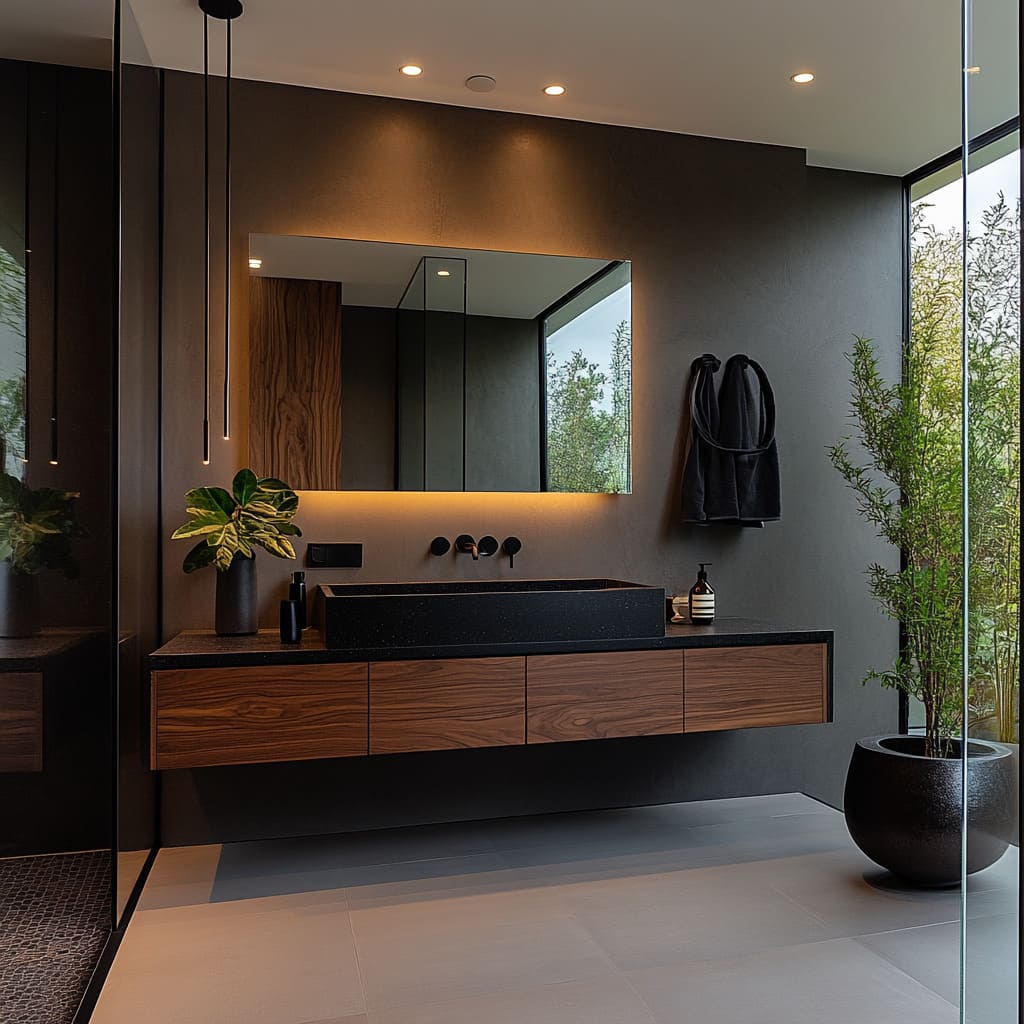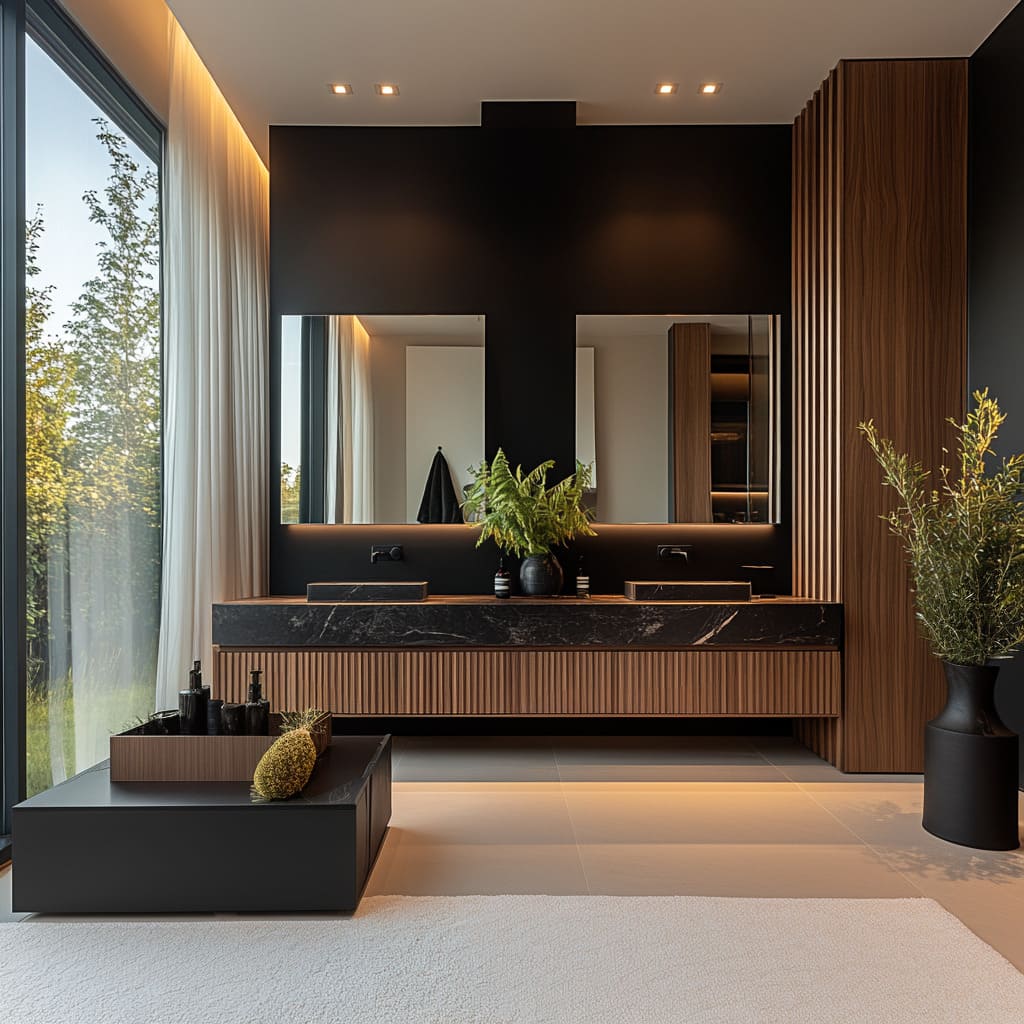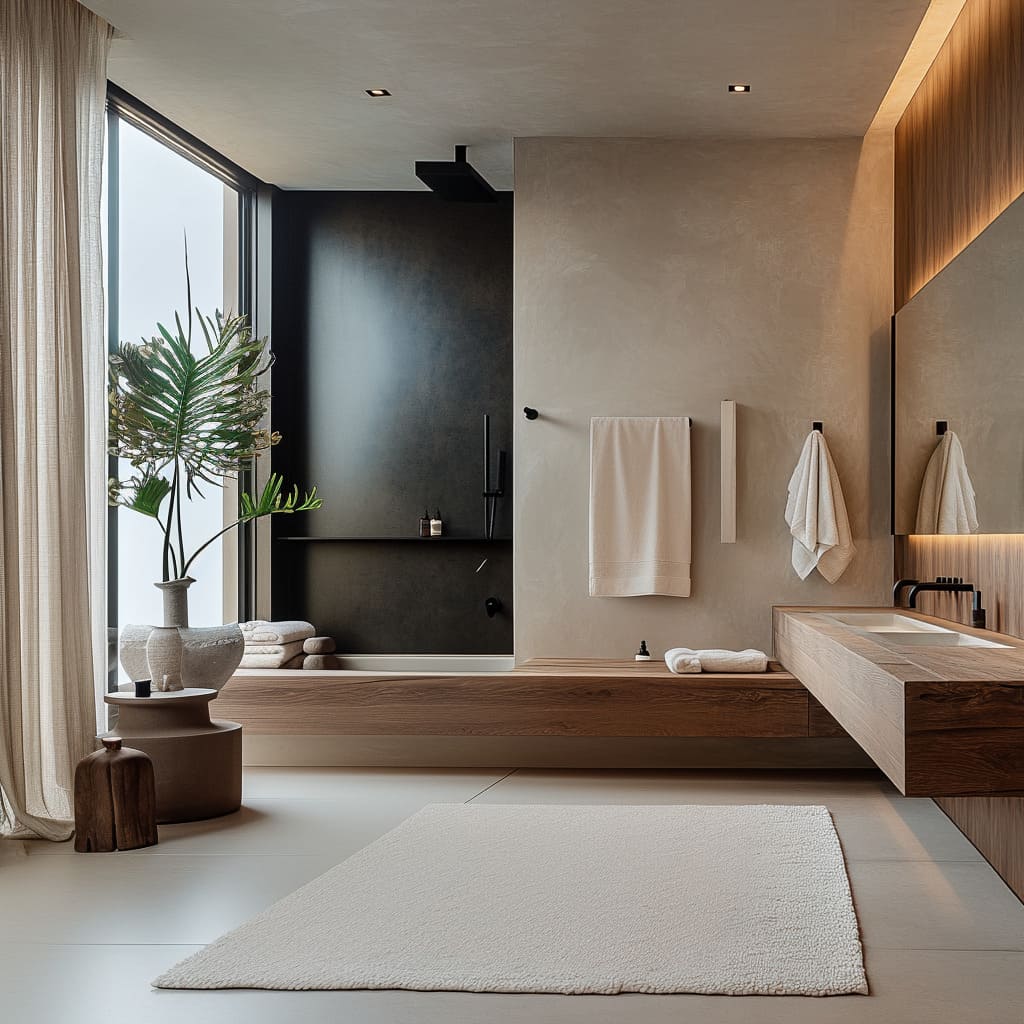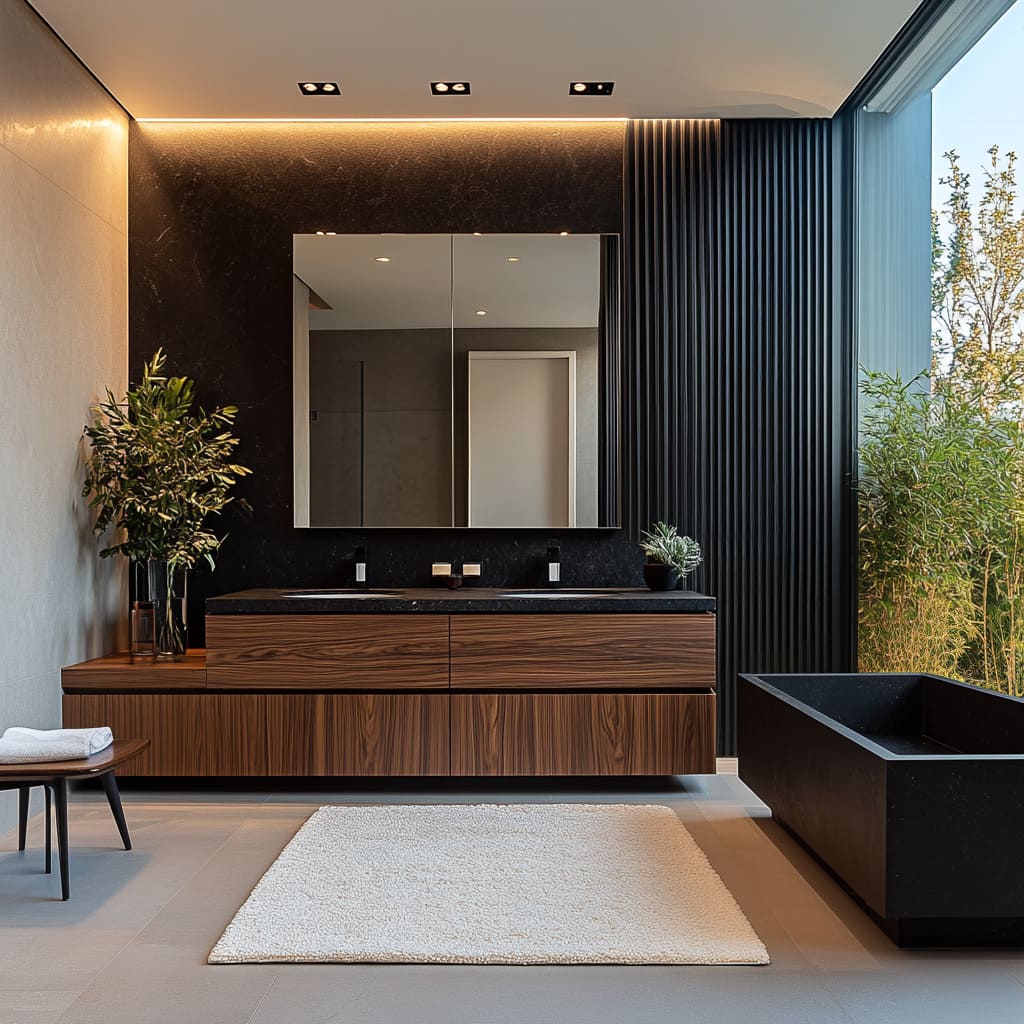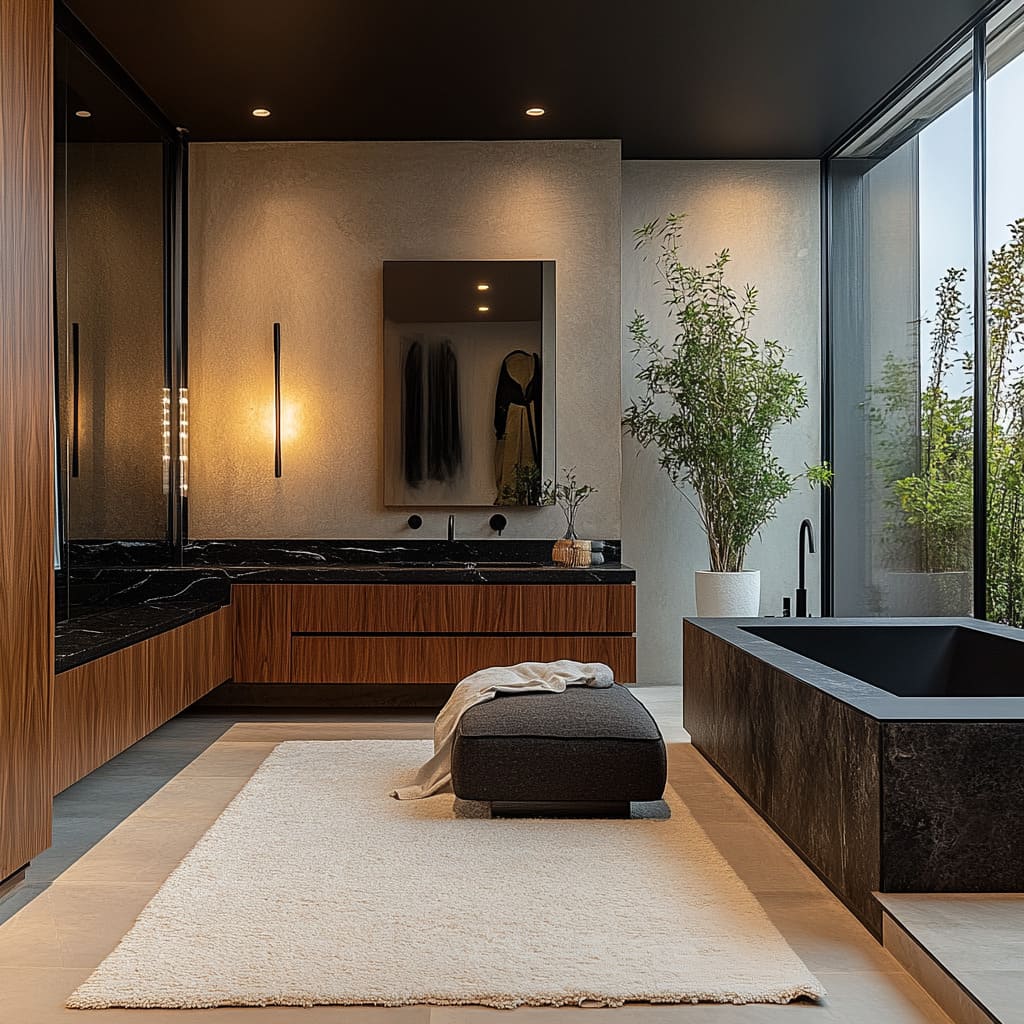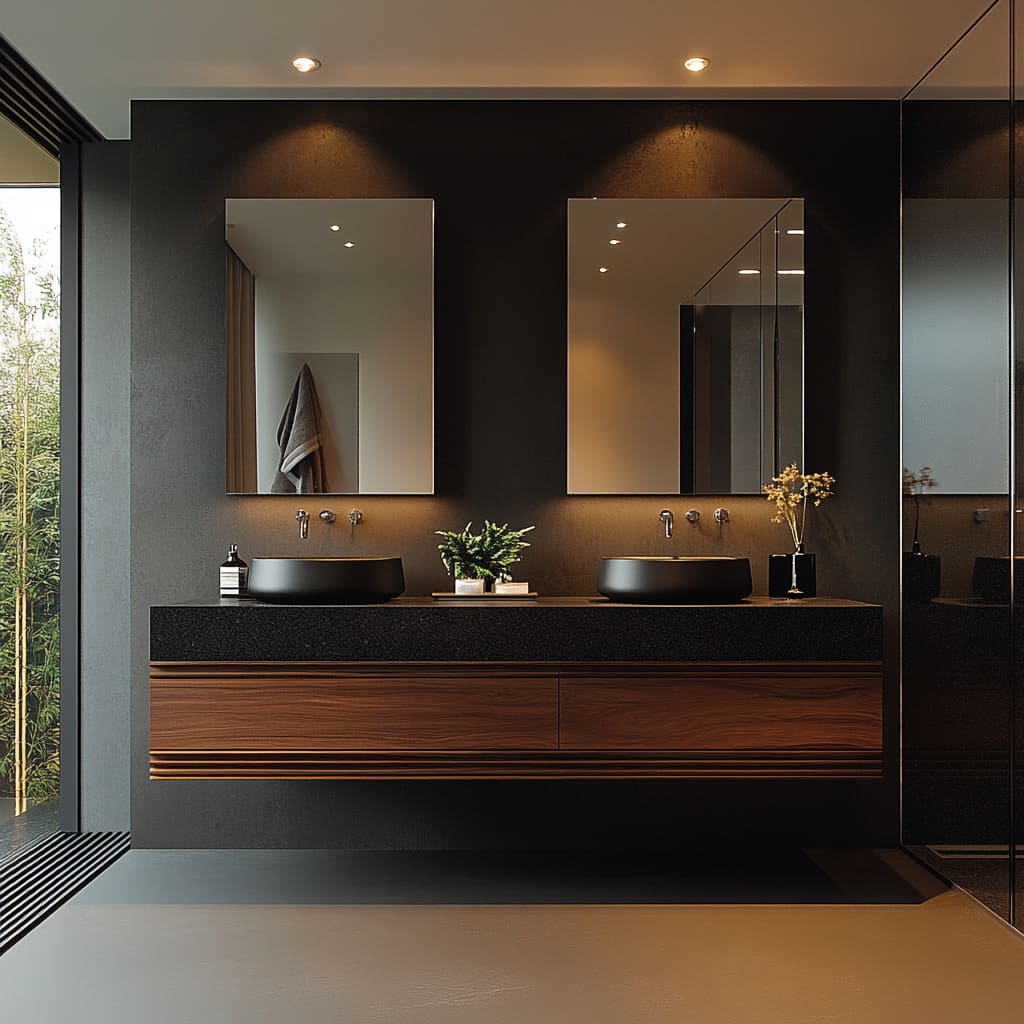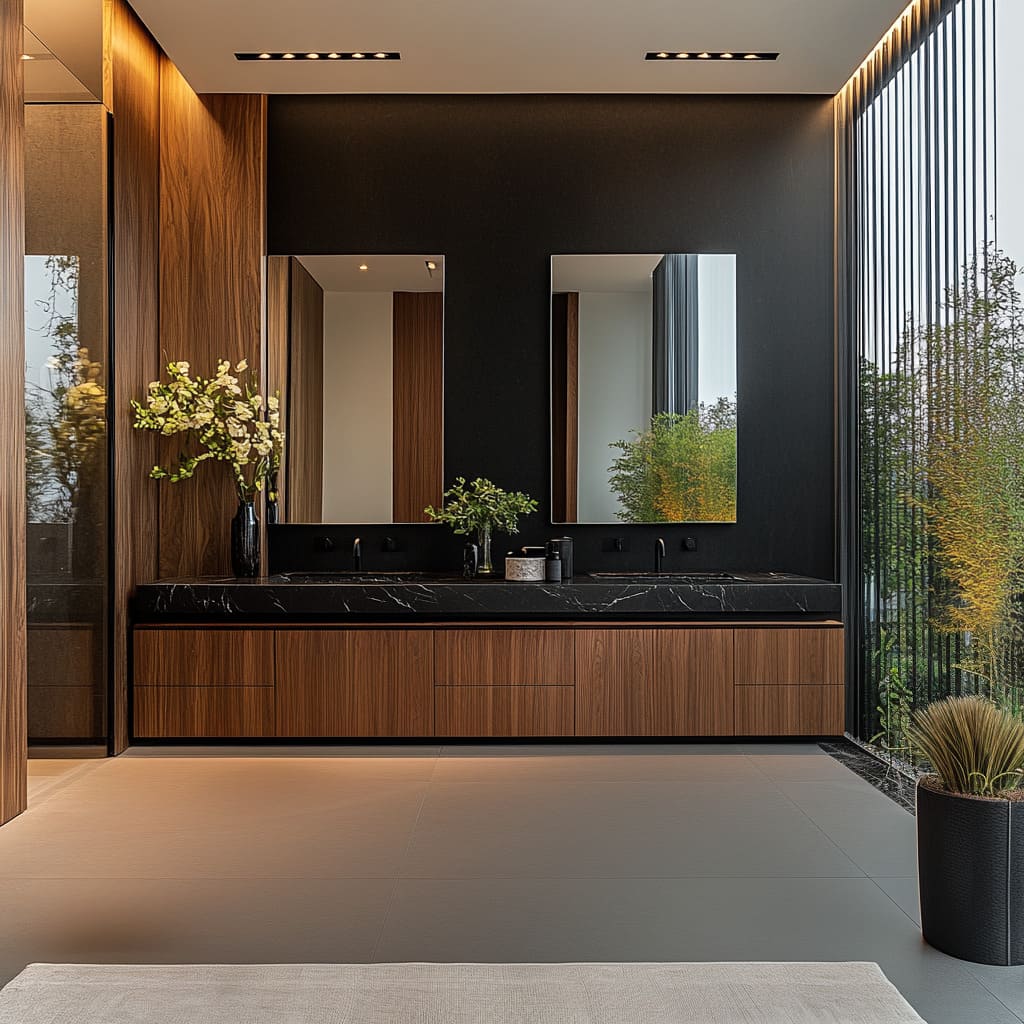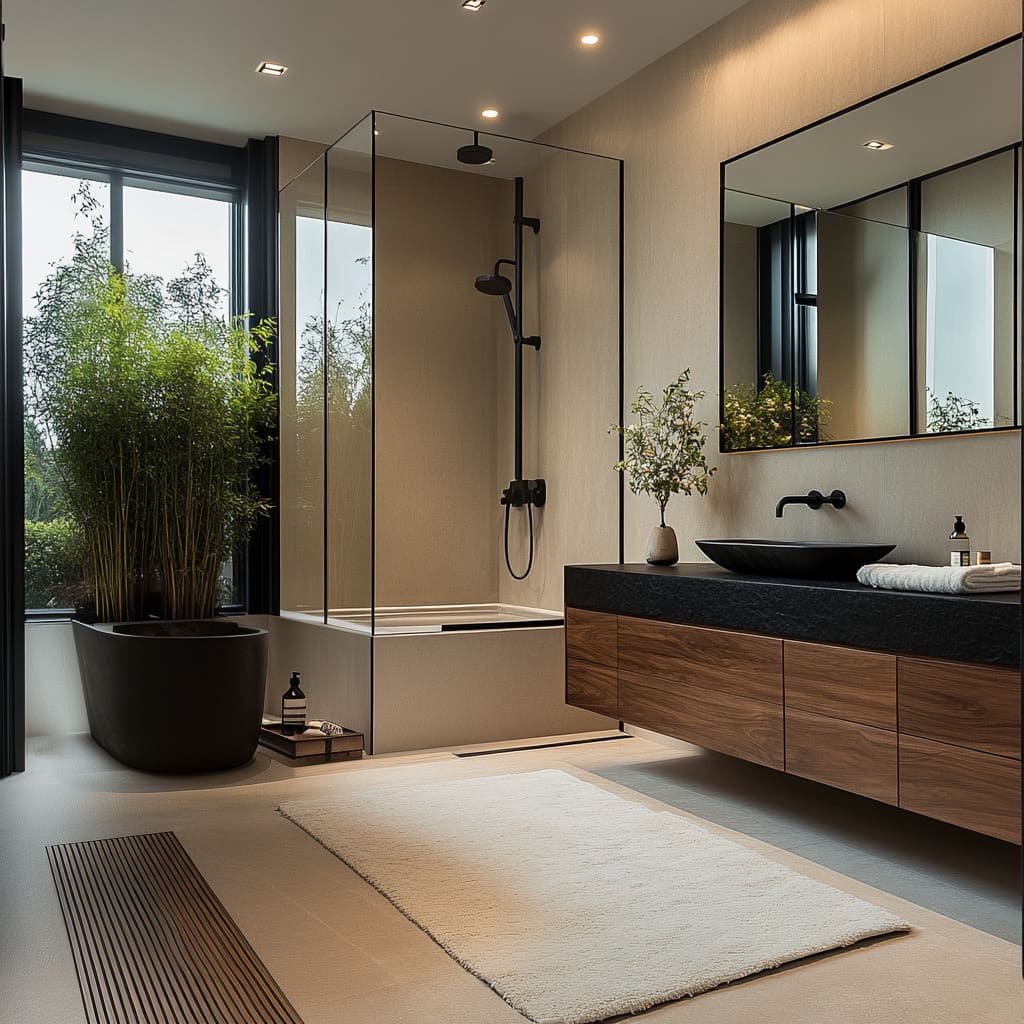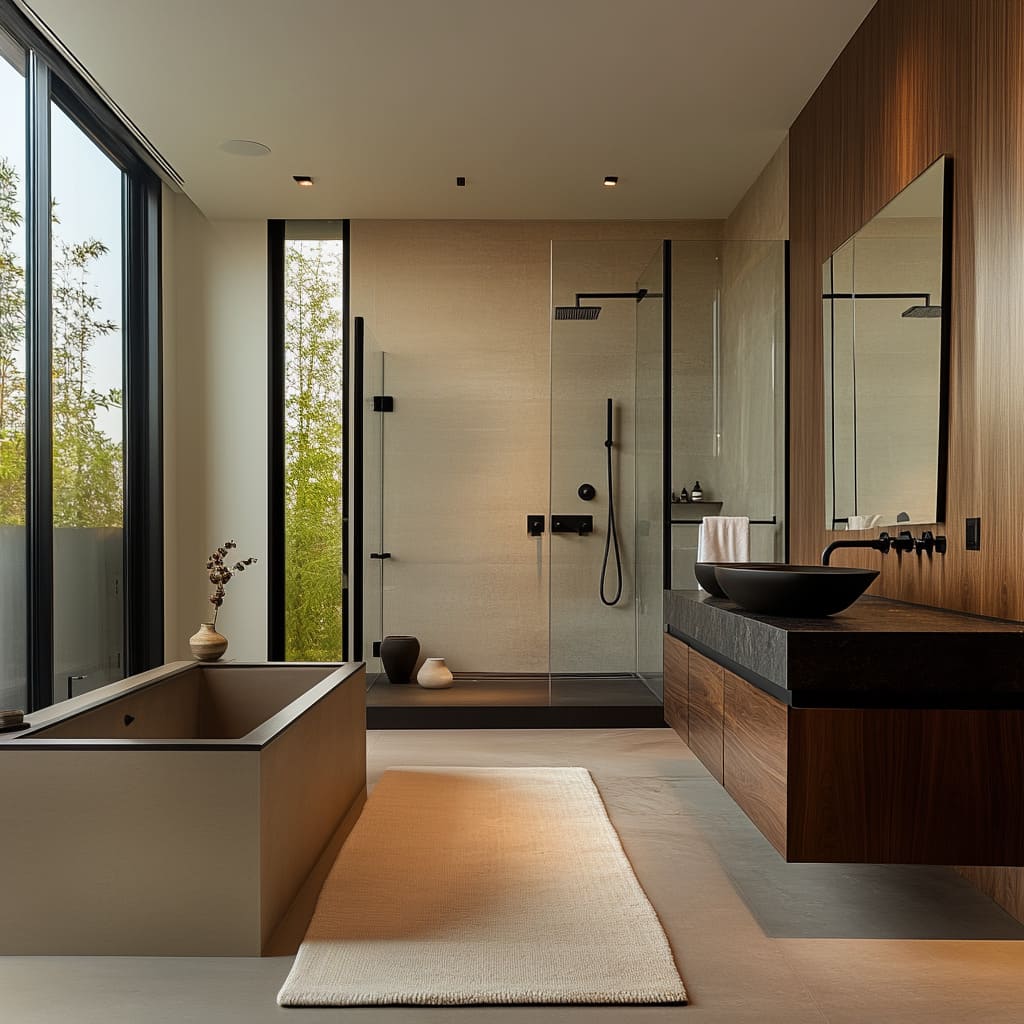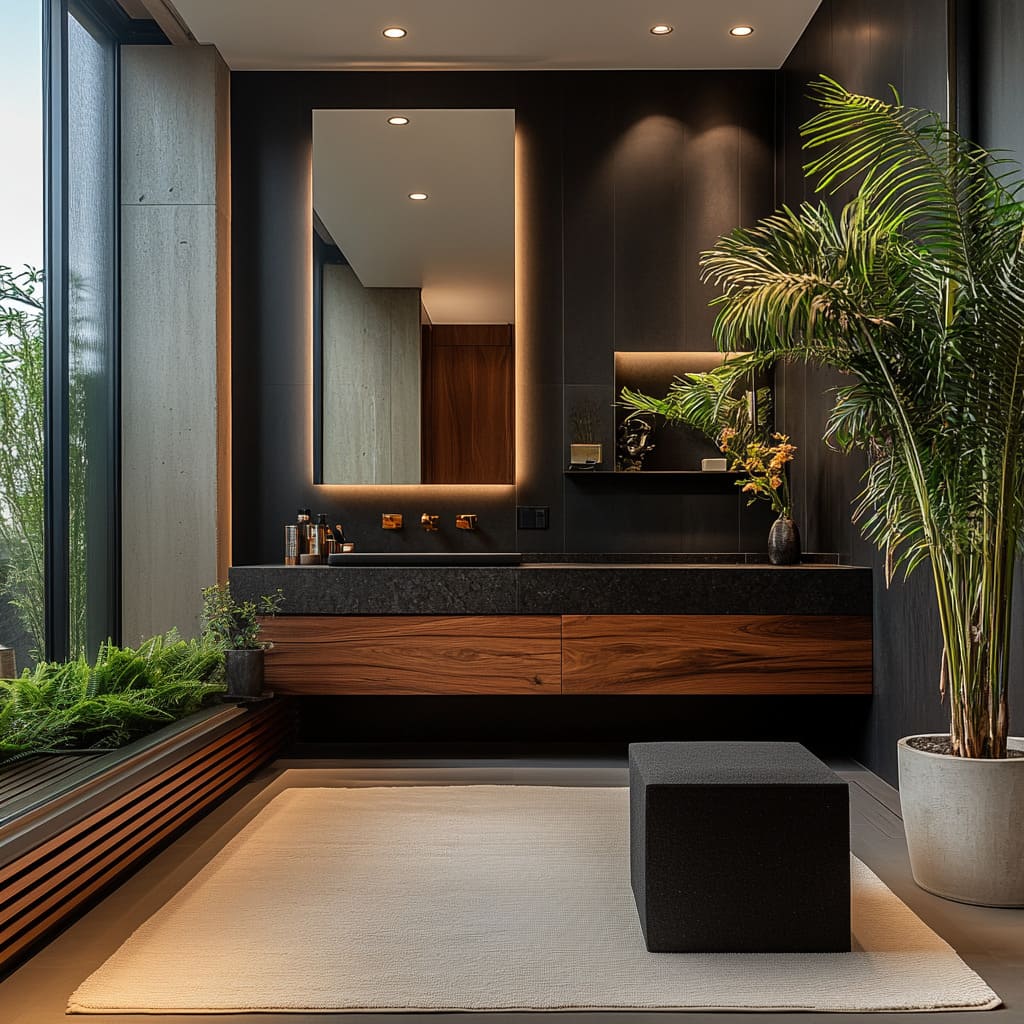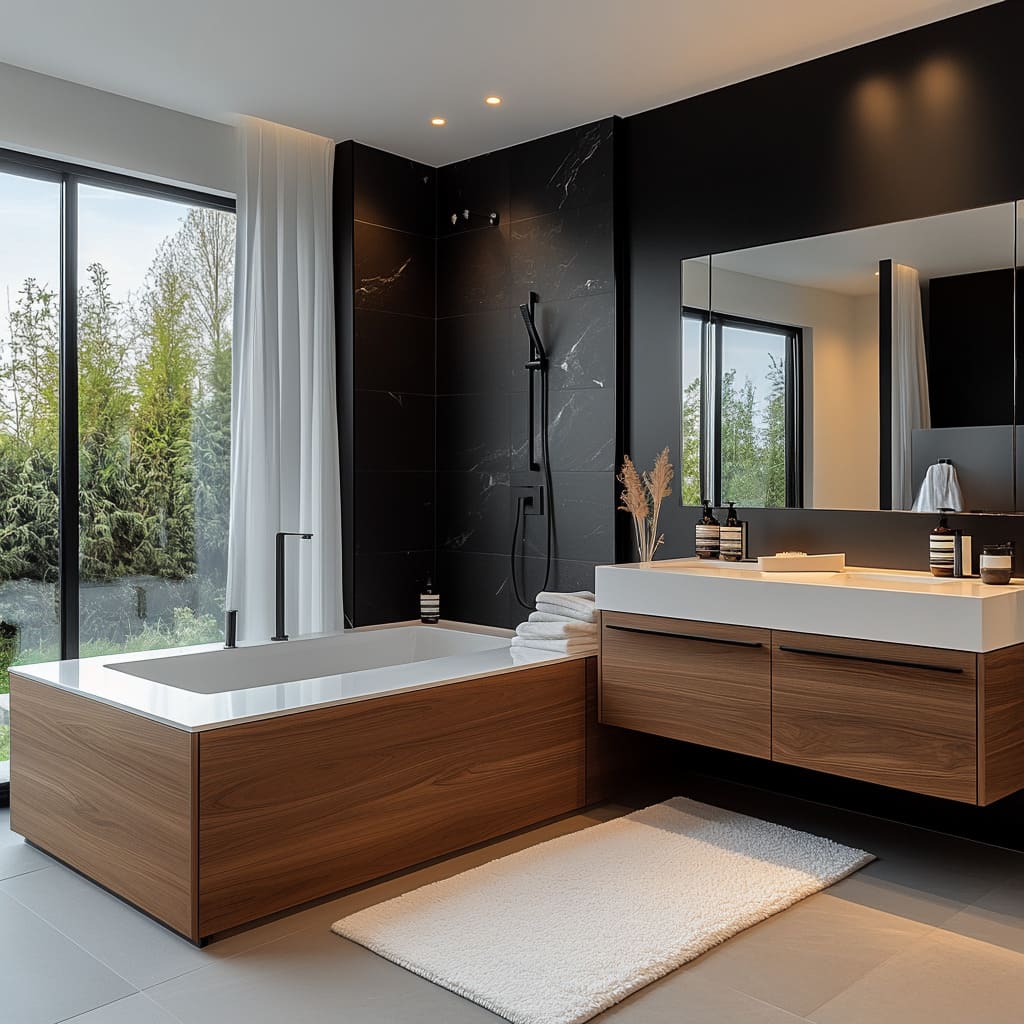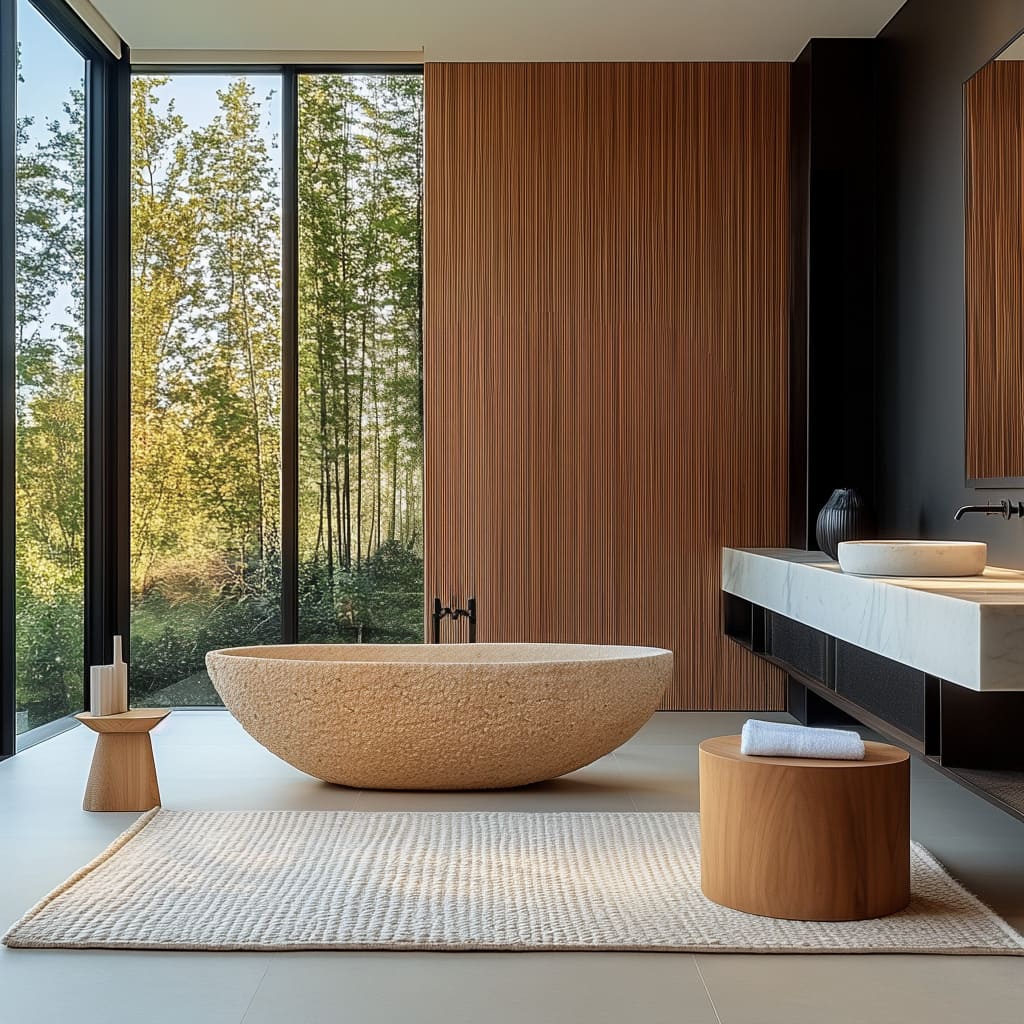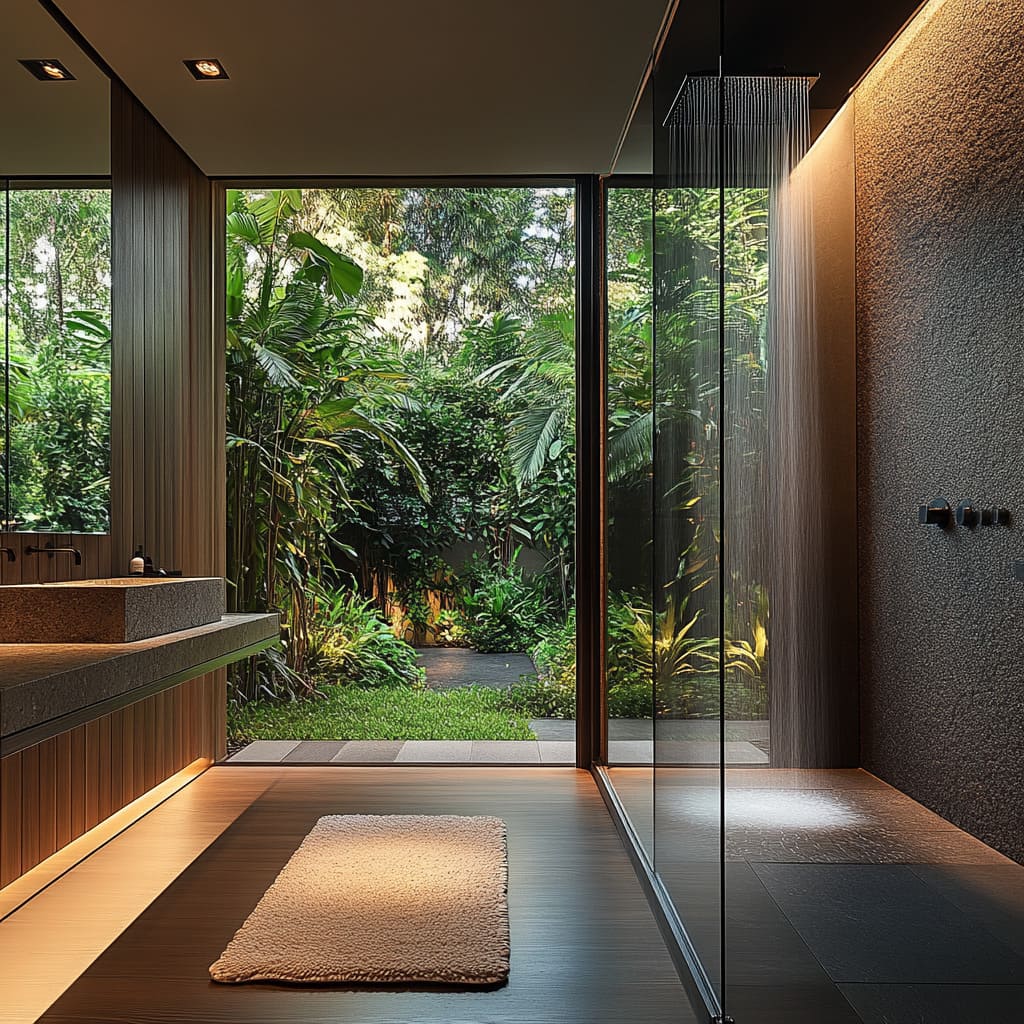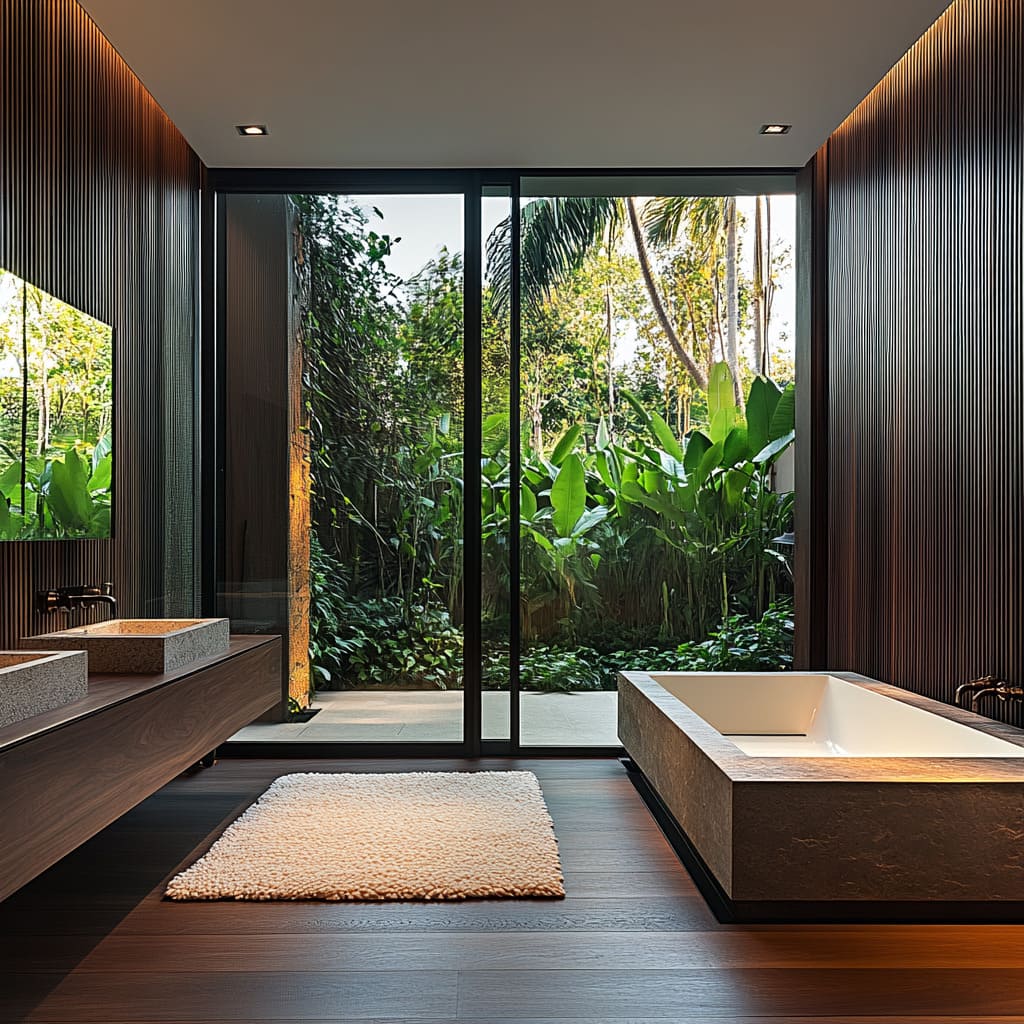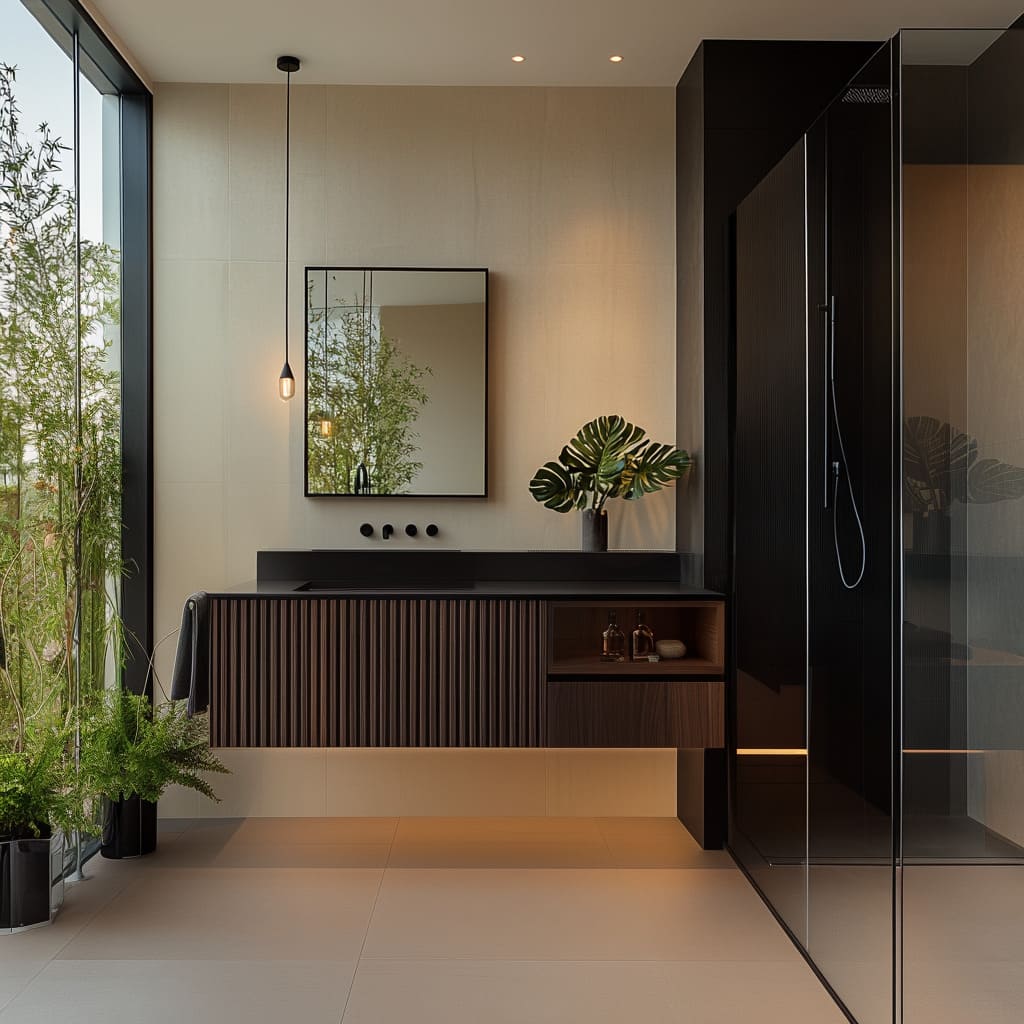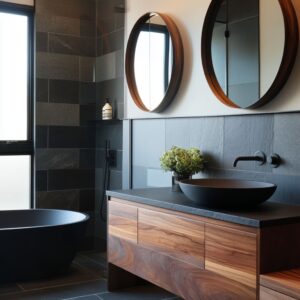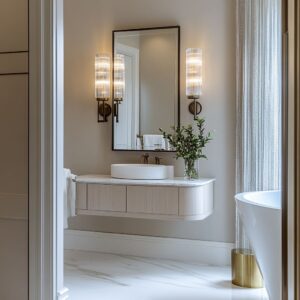The idea of a luxury modern master bathroom has evolved far beyond basic functionality. No longer just a place for routine self-care, today’s high-end bathroom is a refined extension of the home’s architecture, where materials, lighting, and spatial planning come together to create an immersive experience.
With an emphasis on clean lines, rich textures, and a seamless balance between natural and contemporary elements, these bathrooms are designed to feel both sophisticated and deeply comfortable.
What sets these spaces apart is the way they embrace contrast. Dark stone surfaces meet warm wood cabinetry, matte black fixtures complement soft lighting, and structured vanities are balanced by freestanding sculptural bathtubs.
The interplay between these materials creates a setting that feels curated yet effortless, avoiding anything that appears overly decorated or cold. The result is a space that feels just as inviting as it is striking, where every detail—down to the placement of a mirror or the grain of a walnut panel—adds to the overall composition.
Large-format tiles with minimal grout lines, floating cabinetry that enhances openness, and floor-to-ceiling windows framing natural greenery are all key elements in today’s most sought-after designs. Instead of harsh overhead lighting, subtle LED strips and recessed fixtures highlight architectural details, ensuring that materials are displayed in their best light.
Mirrors are no longer just functional but are positioned to amplify natural brightness, enhancing the sense of space and depth.
Another defining characteristic of these bathrooms is the strong connection to nature. Whether through indoor greenery, an outdoor shower, or a strategically placed bathtub overlooking a private garden, designers are prioritizing elements that bring a sense of calm and openness.
The contrast between structured architecture and organic textures keeps the space from feeling overly rigid, making it feel welcoming rather than purely aesthetic. In the world of high-end interiors, a well-designed master bathroom is no longer an afterthought—it’s an essential part of a home’s overall atmosphere.
Through a careful balance of materials, lighting, and thoughtful spatial planning, these bathrooms achieve something beyond visual appeal. They create an environment where design and comfort exist in perfect harmony, setting a new standard for luxury living.
The Art of Contrast: Balancing Geometry and Nature in Contemporary Luxury Bathrooms
Luxury bathroom design has moved far beyond sterile, all-white spaces. Today, the most captivating contemporary luxury bathrooms masterfully balance geometric precision with the warmth of natural materials.
Designers are moving toward a refined mix of textures, where matte black finishes, richly grained wood, and sculptural stone create an atmosphere that feels inviting yet sophisticated. The key to this balance lies in the contrast.
Straight, crisp lines in cabinetry and vanities provide a structured foundation, but they’re softened by the organic appeal of wood grain and the depth of veined marble or stone. Floating vanities, a signature in high-end designs, highlight this contrast beautifully.
Their weightless appearance keeps the space open, allowing the material itself—whether warm walnut, sleek black oak, or light-toned ash—to take center stage.
Matte black elements add another dimension, acting as a grounding force amid the natural finishes. Whether used for faucets, mirror frames, or accent walls, these dark tones prevent the design from feeling overly delicate.
The effect is bold but never harsh, thanks to the careful interplay of textures. A smooth stone basin against a black metal fixture creates visual interest without overwhelming the space.
Beyond aesthetics, the combination of geometric and natural elements has a functional purpose. Large-format tiles with minimal grout lines extend the visual flow of the room, while slatted wood paneling introduces depth without clutter.
Even the smallest details—such as the way recessed lighting interacts with textured surfaces—play a role in shaping the ambiance. Designers know that lighting can make or break the feel of a space, so indirect LED strips and soft backlit mirrors ensure that the materials are showcased in the best possible way.
Another essential aspect is how these elements interact with natural light. Floor-to-ceiling windows are a common feature in high-end designs, allowing sunlight to highlight the rich variations in wood and stone.
Where possible, greenery is incorporated, either through indoor plants or strategically placed outdoor landscaping that frames the view. This seamless transition between indoors and outdoors is what makes these bathrooms feel truly immersive, drawing inspiration from design trends seen in modern homes worldwide.
By thoughtfully combining structured lines with nature-inspired elements, contemporary luxury bathrooms avoid the cold, overly polished look that was once common in modern interiors. Instead, they embrace contrast—dark against light, smooth against textured, structured against free-flowing.
The result is a space that feels intentional, refined, and effortlessly inviting.
Floating Vanities: A Perfect Blend of Lightness and Statement Design
The use of floating vanities in luxury modern bathrooms is more than just a visual preference—it’s a design choice that redefines the way space is perceived. Unlike traditional cabinetry that reaches the floor, these suspended units create an open feel, allowing the flooring to extend uninterrupted.
This technique not only makes the bathroom appear larger but also enhances the natural flow of light, whether from recessed fixtures or windows bringing in daylight. Wood plays a significant role in softening the modern aesthetic.
Walnut and oak, with their rich textures and warm tones, are the materials of choice for these floating vanities. They introduce depth without overwhelming the space, striking a balance between structure and organic appeal.
The clean, handle-free surfaces further reinforce the streamlined look, keeping the design focused on material and form rather than unnecessary embellishments.
Dark stone countertops add another dimension to the composition. With their deep color and bold veining, these surfaces introduce a striking contrast against the lighter wood.
This pairing prevents the design from feeling monotonous, ensuring that each element stands out while contributing to an overall sense of cohesion. The choice of stone—whether black marble, honed granite, or matte quartz—is intentional, creating a visual anchor that grounds the lighter floating vanity.
The absence of traditional legs or toe-kicks gives the illusion that the vanity is weightless, yet this does not come at the expense of functionality. Many designs incorporate under-vanity lighting, casting a soft glow along the floor.
This not only adds to the floating effect but also provides subtle illumination, making nighttime use more comfortable.
In high-end interiors, floating vanities are often paired with large, frameless mirrors that reflect both artificial and natural light, amplifying the sense of openness. The simplicity of these mirrors keeps the focus on the materials rather than intricate details.
When placed above a vanity with a dark stone top, they further enhance the depth of the space, reinforcing the clean and structured aesthetic. What makes these vanities truly effective in luxury modern bathrooms is their ability to balance openness with strong visual impact.
The combination of wood’s natural warmth and stone’s bold presence ensures that the design remains inviting while maintaining a contemporary edge. Instead of feeling rigid or clinical, these spaces feel thoughtfully composed—grounded in simplicity but rich in detail.
How Lighting Shapes Modern Luxury Bathrooms
Lighting in high-end bathrooms is more than a necessity—it’s a carefully crafted element that defines the mood of the space. Instead of relying on bold statement fixtures, many contemporary designs favor understated solutions that create an inviting atmosphere without overpowering the architecture.
Recessed lights, LED strips, and strategically placed indirect illumination work together to highlight textures, enhance depth, and soften dark materials. A key technique in contemporary luxury bathroom ideas is the use of indirect lighting to wash walls and ceilings with a gentle glow.
LED strips integrated behind mirrors or along ceiling edges create a seamless floating effect, making the space feel open and weightless. These soft sources of light prevent harsh shadows and allow materials like black marble, matte stone, or dark wood to feel rich and dimensional rather than overwhelming.
The interaction between light and material is especially important in bathrooms that incorporate bold contrasts. Deep black walls or dark stone vanities can easily absorb too much light, but carefully positioned illumination ensures they remain visually dynamic.
By placing hidden LED strips under floating vanities or along recessed shelving, designers introduce depth without disrupting the minimalist aesthetic. The result is a balanced interplay of brightness and shadow that enhances both the structure and the material itself.
In addition to its role in shaping the mood, lighting also contributes to functionality. Linear lighting under vanity units provides subtle guidance at night, while backlit mirrors ensure an even distribution of brightness for grooming without harsh glare.
Ceiling-mounted recessed lights are often positioned with precision to avoid unwanted reflections on glossy surfaces, making the space feel effortlessly polished. Natural light also plays a vital role in high-end designs.
Floor-to-ceiling windows or skylights allow daylight to filter in, complementing artificial sources and bringing warmth to the space. Where privacy is a concern, frosted glass or sheer curtains diffuse the sunlight, preventing harsh contrasts while maintaining a soft, glowing ambiance.
By combining multiple layers of light—ambient, task, and accent—designers craft bathrooms that feel open, intimate, and visually balanced. Instead of relying on a single bold fixture, they create an immersive experience where lighting seamlessly interacts with textures and materials, making every detail feel intentional.
Integrating Nature into Modern Bathroom Design
Floor-to-ceiling windows have become a defining feature of high-end bathroom interiors, offering more than just an expansive view. By bringing natural greenery into focus, these architectural elements blur the line between indoor luxury and outdoor tranquility.
Instead of treating the window as a simple light source, designers use it as an essential part of the composition, framing lush plants, bamboo screens, or private courtyards as living works of art. In an elegant modern bathroom design, the placement of a freestanding bathtub near a full-height glass wall transforms the entire bathing experience.
Surrounded by natural foliage, the tub becomes more than just a fixture—it becomes an immersive escape. The carefully chosen backdrop of tropical plants, sculptural trees, or a Zen-inspired rock garden enhances the feeling of relaxation, reinforcing the connection to nature.
Vanities and mirrors are also positioned with intention, maximizing reflections of the outdoor greenery. A floating vanity facing a garden view creates an open, airy atmosphere, making daily routines feel less enclosed.
Large, frameless mirrors help extend the visual reach of natural elements, ensuring that even spaces without direct outdoor access feel connected to the surrounding landscape. Material choices play a critical role in bridging this transition.
Warm wood finishes, textured stone, and matte black accents complement the organic tones seen through the window, creating a design that feels cohesive rather than divided. The goal is to allow natural elements to guide the aesthetic rather than compete with it.
In some cases, slatted wood panels or thin metal frames are used to filter light gently, offering privacy without completely blocking the view.
Lighting is another subtle factor that enhances this connection. Daylight pouring in through expansive windows changes the mood of the space throughout the day, while soft interior lighting at night ensures the outdoor elements remain visible even after sunset.
In homes where privacy allows, bathrooms open directly to secluded outdoor areas, extending the functionality of the space with open-air showers or relaxation corners designed for unwinding in nature. This approach to bathroom design is inspired by architectural trends seen in luxury homes worldwide, where indoor spaces are no longer treated as separate from their surroundings.
Instead of confining relaxation to a closed room, these designs embrace openness, offering a private retreat that feels effortlessly connected to the outside world.
Blending Strong Lines with Soft Curves in Luxury Bathrooms
A well-designed bathroom is more than just a collection of high-end materials—it’s about how each element interacts to create a seamless flow. In luxury contemporary master bathrooms, the contrast between structured geometry and soft curves plays a key role in shaping the visual and functional balance of the space.
Vanities, cabinetry, and vessel sinks often follow a linear composition, reinforcing a clean and organized aesthetic. Rectangular or square sinks, whether integrated into the vanity or placed as a sculptural piece on the countertop, extend this structured approach.
The same principle applies to floating vanities, which emphasize straight lines while maintaining a sense of openness. The repetition of these precise edges creates a strong architectural foundation, giving the space a crisp, intentional look.
However, without variation in form, a bathroom can start to feel overly rigid. This is where curves become essential.
Freestanding bathtubs, particularly those with an oval or asymmetrical silhouette, introduce a fluid counterpoint to the straight-edged vanities and cabinetry. These rounded forms soften the overall aesthetic, making the space feel more inviting while preventing visual monotony.
In some designs, the bathtub itself becomes a sculptural statement, its shape echoing the natural flow of water and enhancing the sense of relaxation.
Material choice further enhances this contrast. A black marble countertop with strong veining against a smooth stone vessel sink creates depth and variation.
Matte finishes on bathtubs or sinks reduce glare and add a tactile quality, while polished stone surfaces catch light, reinforcing their form. The pairing of these textures keeps the space visually dynamic, ensuring that no single element feels out of place.
Even the placement of fixtures plays a role in achieving this balance. In larger layouts, bathtubs are often centered or positioned near floor-to-ceiling windows, giving them prominence while maximizing natural light.
Meanwhile, wall-mounted faucets and recessed shelving reduce visual clutter, allowing the mix of shapes and materials to stand out without feeling overwhelming. Ultimately, this balance between structured lines and organic curves defines the sophistication of modern bathroom design.
It’s not about choosing one over the other but about ensuring that each form enhances the next, creating a space that feels both refined and effortless.
The Role of Greenery: Softening Dark Tones in Luxury Bathroom Design
Bringing nature into modern high-end bathrooms is not just about aesthetics—it’s about balance. Dark walls, deep-toned countertops, and black metal fixtures create a bold and refined atmosphere, but without contrast, they can feel heavy.
Greenery is the perfect counterbalance, introducing an organic softness that prevents the space from feeling too structured or monochromatic. Potted plants are one of the simplest yet most effective ways to introduce this natural contrast.
A tall, leafy plant placed beside a freestanding bathtub or near a floor-to-ceiling window immediately brings movement and vitality to the space. The flowing shapes of broad leaves or delicate fronds stand out against strong architectural lines, ensuring the room doesn’t feel too rigid.
For those who prefer a more understated approach, smaller touches of greenery can be just as impactful. A moss-filled ceramic bowl on a vanity or a row of low-maintenance succulents on an open shelf add a refreshing presence without overpowering the minimalism of the space.
The key is subtlety—designers carefully choose plant varieties that complement the materials used in the bathroom rather than compete with them. Vases with single branches or delicate dried botanicals offer another way to bring in organic shapes without overwhelming the design.
A sculptural branch in a matte black or stone-textured vase adds just enough contrast to break up the strong lines of the surrounding surfaces. The simplicity of these arrangements enhances the overall composition, reinforcing the idea that nature and luxury can exist in harmony.
Beyond their visual impact, plants contribute to the ambiance of the space. In bathrooms with large windows, greenery positioned near the glass strengthens the indoor-outdoor connection, making the space feel more immersive.
In dimly lit or moody interiors, the presence of greenery offsets the darkness, ensuring that the space remains inviting rather than stark. This integration of natural elements isn’t just a passing trend—it’s a fundamental aspect of modern luxury design.
By thoughtfully incorporating greenery, designers create a softer, more inviting environment where bold materials feel less imposing and the space as a whole feels effortlessly refined.
The Balance of Texture and Reflection in Luxury Bathroom Design
One of the most striking features of luxury modern master bathroom designs is the careful interplay between textured surfaces and reflective elements. This balance is what gives these spaces their depth, ensuring that every material contributes to a layered and visually engaging composition.
Without contrast, a bathroom can feel either overly flat or excessively polished, but when executed well, the mix of matte, glossy, smooth, and textured finishes creates an atmosphere that feels both rich and thoughtfully composed. A common technique in high-end designs is pairing matte black walls with high-polish stone or marble.
This contrast not only makes each material stand out but also enhances the way light interacts with the surfaces. For example, a dark, velvety-textured wall absorbs light, making the space feel more intimate, while a polished marble vanity top reflects light back into the room, preventing it from feeling too heavy.
This subtle push and pull between absorption and reflection ensures that darker palettes remain inviting rather than overwhelming.
Wood paneling is another key player in creating depth. Slatted or ribbed wood panels, often seen behind vanities or as feature walls, add a sense of movement that contrasts with the smoothness of concrete or polished stone.
These panels catch light at different angles throughout the day, changing the visual dynamic of the space. The use of rich walnut or oak, paired with cool-toned stone, prevents the design from feeling one-dimensional, offering a mix of warmth and structure.
Mirrors take this balance a step further. Large, frameless mirrors—sometimes spanning an entire wall—serve a dual purpose.
First, they reflect natural light from nearby windows, amplifying brightness without the need for excessive artificial lighting. Second, they visually double the impact of textural elements, making even a compact space feel more expansive.
In some cases, mirrors are positioned opposite feature walls to create the illusion of extended depth, reinforcing the sense of openness. This thoughtful approach to texture and reflection ensures that no single element overpowers the space.
Instead, materials work together to enhance the overall composition, creating a master bathroom that feels refined, structured, and effortlessly balanced.
Conclusion: The Art of Balance in Modern Luxury Bathrooms
Luxury bathroom design today is about far more than minimalism—it’s about achieving a refined balance between structure and warmth, simplicity and depth, functionality and visual impact. These spaces stand out because of their thoughtful layering of materials, where floating vanities introduce lightness, dark stone surfaces add richness, and slatted wood panels bring warmth and movement.
Each element is placed with precision, ensuring that the final result is not only visually striking but also deeply functional. What makes these bathrooms remarkable is their ability to feel both calming and high-impact at the same time.
The contrast of smooth and textured surfaces creates a dynamic composition that never feels one-dimensional. Matte black fixtures disappear seamlessly into the design, while polished stone countertops introduce just enough reflection to keep the space feeling open.
Large mirrors amplify light, enhancing the sense of space without needing excessive artificial illumination.
Natural elements play a key role in softening the structured aesthetic. Whether through greenery, organic stone finishes, or wood accents, these bathrooms feel connected to nature rather than isolated from it.
Floor-to-ceiling windows and integrated courtyards bring the outdoors into the design, reinforcing a sense of openness. Even in spaces dominated by deep, moody tones, the presence of plants or natural textures ensures a welcoming atmosphere.
Despite their clean lines and refined color palettes, these bathrooms never feel cold or impersonal. The combination of bold geometric forms with softer curves—such as an oval freestanding tub against a linear vanity—ensures that the space remains visually engaging.
The thoughtful use of lighting, whether through recessed fixtures, under-vanity LEDs, or indirect mirror backlighting, adds depth and warmth, preventing the darker tones from feeling too heavy.
Ultimately, these bathrooms are a testament to the power of contrast. By combining dark with light, sleek with textured, and modern with natural, designers create spaces that feel effortlessly sophisticated.
Every detail, from the placement of a vessel sink to the grain of a wood panel, is chosen with intention. This is what sets these high-end bathrooms apart—not just their materials or finishes, but the way every feature is carefully considered to create a space that feels balanced, inviting, and unmistakably luxurious.
